Tenmoku belongs to the category of ancient crystalline glazes with a high iron content. During the high-temperature firing process, the variations in firing temperature and atmosphere inside the kiln give rise to unique patterns on the glaze surface.
These glaze patterns are different from the splendid colors or intricate carvings. They are the result of changes in the glaze material at certain temperatures and atmospheres, unpredictable and seemingly the work of "kiln gods." They possess mysterious artistic charm and have won the admiration and praise of many literati and scholars. Tenmoku generally has a thick glaze layer and a rich glaze solution.

The common feature of Tenmoku's shape is a large mouth and a small foot, resembling a funnel. Based on the changes in the rim, belly, and foot, Tenmoku's shapes are divided into four types: "bundled mouth," "contracted mouth," "flared mouth," and "open mouth." Each type is further divided into large, medium, and small sizes, with medium and small sizes being the most common. The large-sized Tenmoku has a diameter of over 15cm, the medium-sized has a diameter between 11cm and 15cm, and the small-sized has a diameter below 11cm.
Open mouth: The characteristic of an open mouth Tenmoku is that the rim flares outwards with a pointed round lip, the belly wall is straight or slightly curved, and the foot ring is relatively shallow. The shape of an open mouth Tenmoku resembles a funnel, hence it is also known as Douli Tenmoku (hat-shaped Tenmoku).
Flared mouth: The characteristic of a flared mouth Tenmoku is that the rim also flares outwards, with some curves at the lip, a longer and curved belly, and a relatively shallow foot ring. There are large, medium, and small sizes of flared mouth Tenmoku. The production of large flared mouth Tenmoku is very rare and valuable, while small and medium sizes are more common.
Gathered mouth: The characteristic of a gathered mouth Tenmoku is that the rim slightly tapers inwards, with a relatively short foot ring and a full shape, some of which have solid and round feet.
Tied-mouth: Tenmoku has an elegant and diverse shape, among which the tied-mouth Tenmoku is a unique creation of the Tenmoku kiln. The characteristic of a tied-mouth Tenmoku from the Tenmoku kiln is that there is a tied-mouth line on the rim, which is a shallow groove that is tied inward at about 1 cm below the rim.
The function of this groove is to fully grasp the amount of tea soup during the tea ceremony and also to prevent the tea soup from overflowing outward. Therefore, the groove on the tied-mouth Tenmoku is also called the "water injection line." Its belly curve is slightly arched, the lower abdomen is inward, and the foot is a shallow circle, resembling a funnel. The tied-mouth Tenmoku is the most representative type of Tenmoku.
Tenmoku is a product that naturally crystallizes and colors after being glazed and fired, so it is also called "natural glaze." The crystal patterns of the glaze color and glaze surface are uncontrollable, impossible to imitate, and constantly changing. The glaze color can be divided into five categories: Wu Jin (dark blue), Rabbit Fur, Oil Drop/Partridge Spot, Yao Bian, and Mixed Color Glaze.
Wujin (Dark Blue) Glaze: The term "dark blue" was already recorded in Cai Xiang's "Tea Record" during the Song Dynasty: "The one made in Tenmoku'an is dark blue, with patterns like rabbit fur..." This is the more typical glaze color of Tenmoku kiln black porcelain. Some Wujin glazes have a surface that is as black as lacquer, while others have a black color with a hint of green. In addition, some have a black-brown or soy black color. Generally speaking, the soy black glaze layer is generally thinner, without any patterns, and the glaze color of early Tenmoku mostly belonged to this category. The glaze surface is slightly dull, black but not lustrous, showing a simple and elegant beauty.
Rabbit Fur Glaze: The term "rabbit fur" also appeared frequently in Song Dynasty literature, such as in the "Tea Record" where it says "patterns like rabbit fur," in Zhu Mu's "Fangdian Shenglan" where it says "Rabbit Fur Tenmoku, produced from the water of Ouning is auspicious," and in the poetry of Su Dongpo, Huang TingTenmoku, Yang Wanli, and others where this term appears frequently.
Rabbit Fur is the most typical and largest produced product of Tenmoku Kiln, so much so that people often use "Rabbit Fur Tenmoku" as a synonym for Tenmoku. The so-called "rabbit fur" refers to the even and dense silk-like patterns that infiltrate through the black base glaze, resembling the fur on a rabbit's body. Due to factors such as "kiln transformation," the rabbit fur patterns can vary in length and thickness, and also exhibit color changes such as gold and silver, commonly referred to as "Golden Rabbit Fur" and "Silver Rabbit Fur," among others.
Emperor Huizong of Song wrote in the "Treatise on Tea" that "the color of the Tenmoku should be valued for its blue-black hue and the quality of its jade-like rabbit fur patterns." In his poem "Visiting You Far Away and Arriving at the New Year with Fresh Tea," Huang TingTenmoku wrote "the pine breeze turns the crab eyes, and the milk foam shines like rabbit fur." Cai Xiang also praised the rabbit fur Tenmoku in his "Tea Tasting" essay, saying "the newly made purple bowl with rabbit fur patterns and the clear spring water boiled in a crab eye Tenmoku. Frozen into flower shapes like snow, suspended in the cup like clouds. It is desired that the ripples in the pond will turn into raindrops falling in the human world."
Oil-spot glaze: The term "oil-spot" first appeared in Japanese literature at the end of the 14th century or the beginning of the 15th century. It has not been found in ancient Chinese literature. Some scholars believe that "oil-spot" refers to the "partridge-feather" mentioned in Song Dynasty literature. The partridge is a common bird in the mountains of northern FuTenmoku, and "partridge-feather" is like the feathers on the chest of a partridge.
The term "partridge-feather" appeared frequently in Song Dynasty literature, such as in Tao Gu's "Qing Yi Lu": "In the making of cups in central FuTenmoku, the pattern is of partridge-feather spots. It is used to test the quality of tea by connoisseurs." Huang Lu Zhi wrote in his poem: "Tenmoku'an porcelain bowls with partridge-feather spots." Monk Huihong also wrote in his poem: "Of the three flavors of tea from the capital, the partridge-feather spot absorbs the spring dew the most." Chen Tenmoku Shu praised in his literary works: "The partridge-feather king's crown is transported throughout the universe, and the rabbit hair cup's snow-like mind becomes a clear spring."
The so-called "Oil Spot" refers to numerous small spots with a golden or silver metallic luster scattered on a blackish glaze or around the mouth of a ceramic ware, hence the distinction between "Golden Oil Spot," "Silver Oil Spot," and "Golden Mouth Oil Spot." These spots are mostly circular, varying in size, with larger ones having a diameter of three to four millimeters and the largest reaching one centimeter, while smaller ones may be as small as a pinhead. They are formed by scattered drops of boiling oil, creating a dazzling effect on the viewer's eyes.
Oil Spot is also a type of crystalline glaze that is difficult to fire and has a low yield. Therefore, there are very few surviving or excavated pieces. A Southern Song Dynasty Oil Spot "Tianmu" bowl in the collection of the Shizuoka Prefectural Museum of Art in Japan is considered a national treasure. In Japanese literature, "Oil Spot" is limited to precious porcelain items that exhibit "Yao Bian" (lit. "glow and change"). In the modern collecting world, "Oil Spot" is also a rare and highly sought-after treasure among Tenmoku ware.

Yao Bian: The term "Yao Bian" was recorded at the latest in the "Chanzhong Xiaoge" (Zen Forest Small Song). In the "Juntai Xian Zuo You Zhang Ji," written in the early 16th century, precious Tenmoku ware was classified into several grades, among which "Yao Bian" was listed as "the supreme divine item of Tenmoku ware, unparalleled in the world." The so-called "Yao Bian" refers to irregular dots gathered on a black glaze, with the dots appearing yellow and emitting a dazzling rainbow-like light mainly in blue around them, hence the name.
Yao Ban is widely spread on the inner wall of Tenmoku ware and changes with the viewing direction. It appears blue when viewed vertically and flashes golden light when viewed obliquely. Due to the extreme difficulty in firing "Yao Bian," very few have been handed down through the ages. Japan only collects four pieces, among which three have been designated as "national treasures" and one as an important cultural property.
Mottled glaze: Due to the "kiln transformation" of black glazed wares from the Tenmoku kiln, the glaze surface has various textures. In addition to the four major categories of glaze surface textures mentioned above, there are also some mottled glazes, such as persimmon red, crimson, soy sauce glaze (soy sauce green, soy sauce black, soy sauce yellow, etc.).



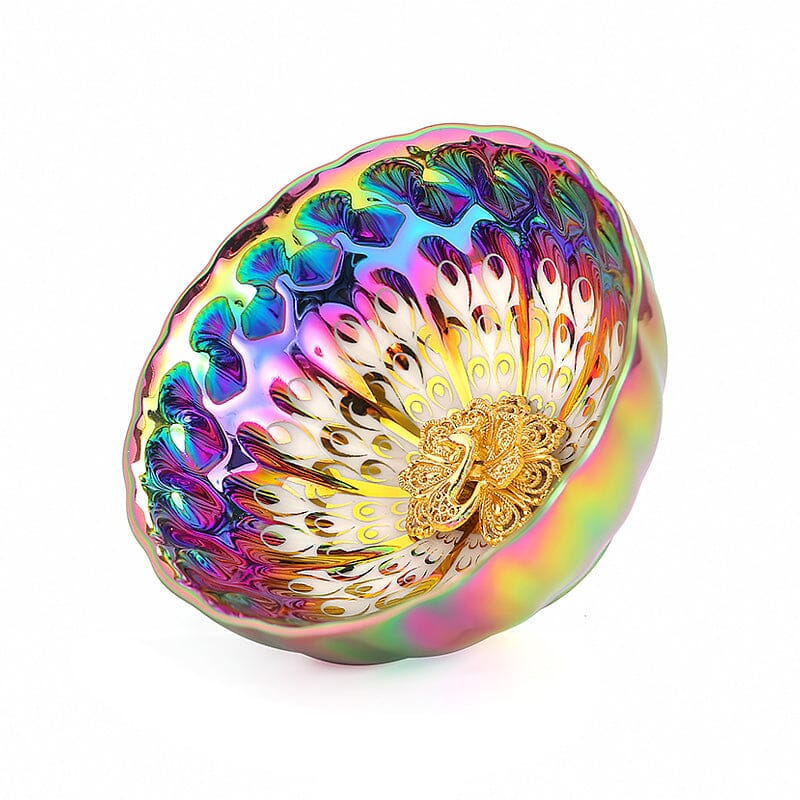
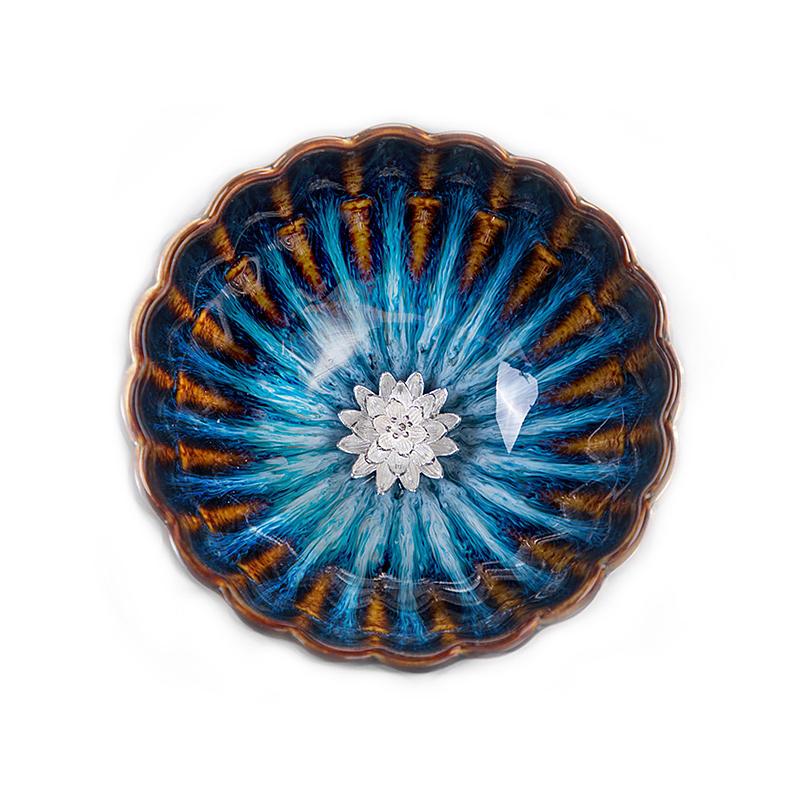
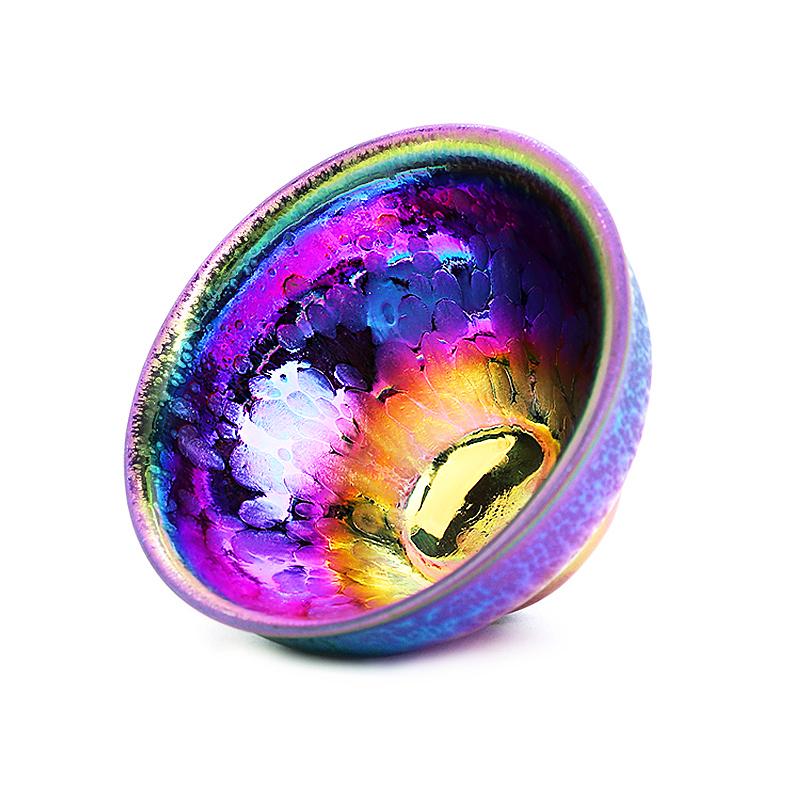
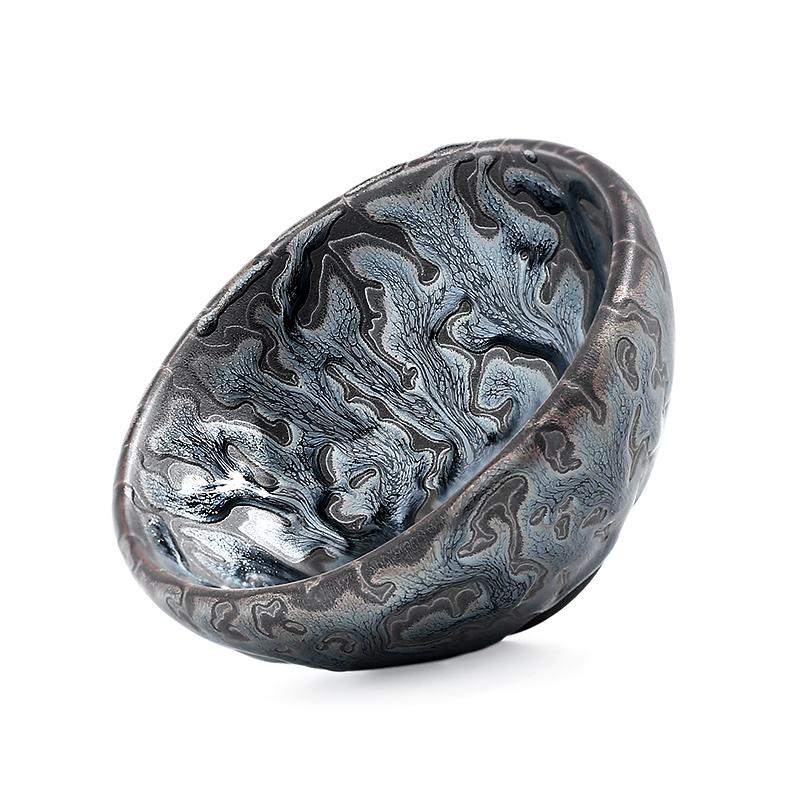
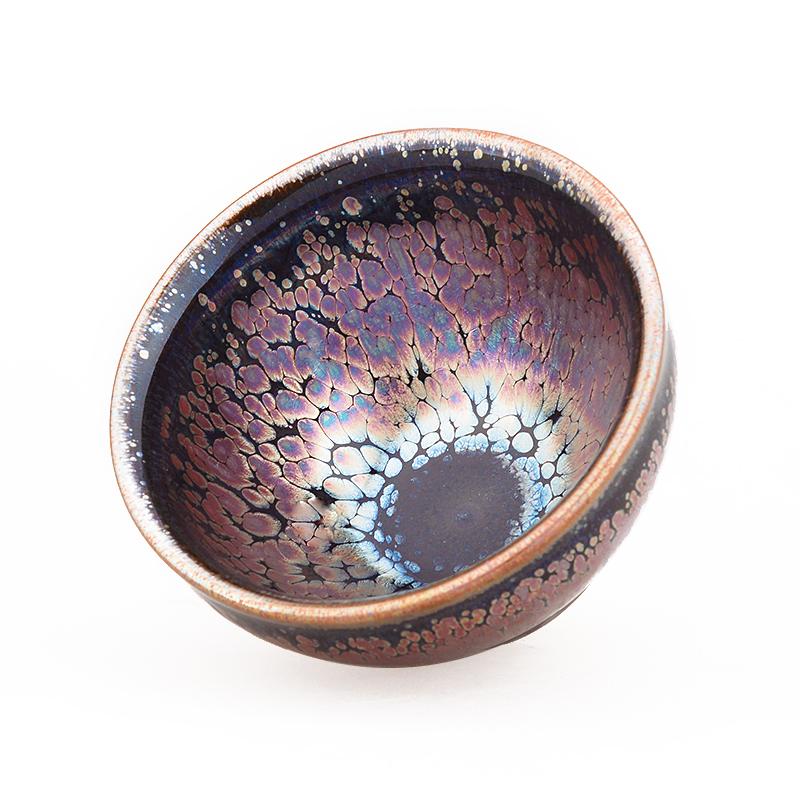
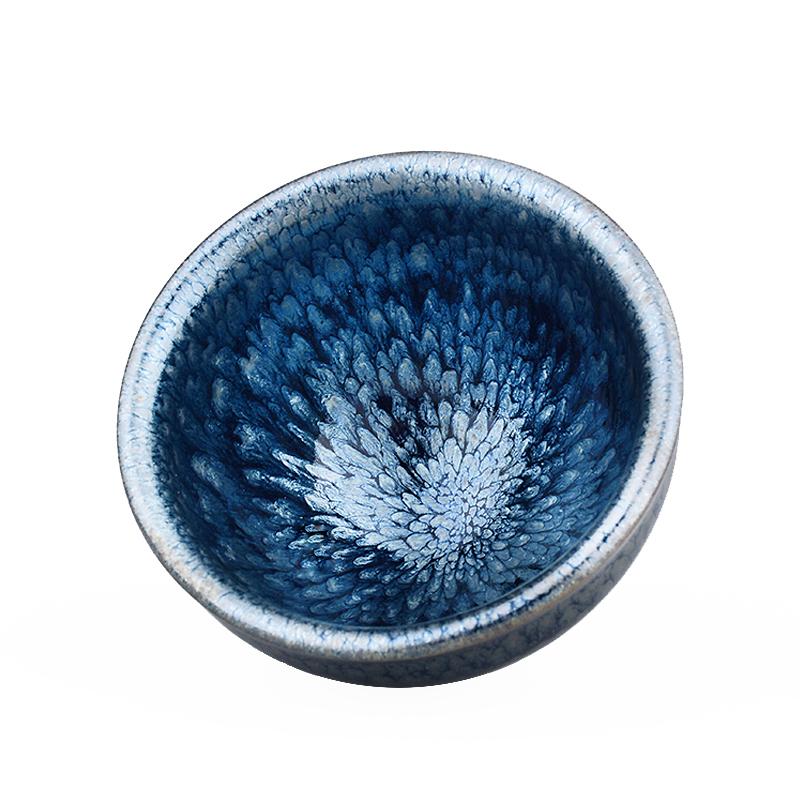
Share:
What determines the price of Tenmoku? Not knowing could lead to a big loss
Is Tenmoku poisonous? I'm afraid you're just joking too much.